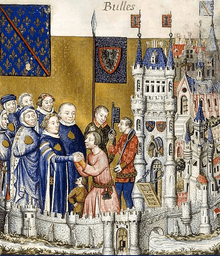Clermont, Oise
Clermont (French pronunciation: [klɛʁmɔ̃]) is a commune in the Oise department in northern France.[2]
Clermont | |
|---|---|
Subprefecture and commune | |
 The church and town centre in Clermont | |
.svg.png) Coat of arms | |
Location of Clermont 
| |
 Clermont  Clermont | |
| Coordinates: 49°22′47″N 2°24′48″E | |
| Country | France |
| Region | Hauts-de-France |
| Department | Oise |
| Arrondissement | Clermont |
| Canton | Clermont |
| Intercommunality | Clermontois |
| Government | |
| • Mayor (2014-2020) | Lionel Ollivier |
| Area 1 | 5.81 km2 (2.24 sq mi) |
| Population (2017-01-01)[1] | 10,147 |
| • Density | 1,700/km2 (4,500/sq mi) |
| Time zone | UTC+01:00 (CET) |
| • Summer (DST) | UTC+02:00 (CEST) |
| INSEE/Postal code | 60157 /60600 |
| Elevation | 48–162 m (157–531 ft) (avg. 54 m or 177 ft) |
| 1 French Land Register data, which excludes lakes, ponds, glaciers > 1 km2 (0.386 sq mi or 247 acres) and river estuaries. | |
History
Clermont was also known as Clermont-en-Beauvaisis[2] or Clermont-de-l'Oise. The town is built on a hill surmounted by a 14th century keep. It is the relic of a fortress that was used as a penitentiary for women.[2] The church dates from the 14th to the 16th centuries. The hôtel-de-ville, built by King Charles IV, who was born in Clermont in 1294, is the oldest in the north of France.[2]
The town was probably founded during the time of the Norman invasions, and was an important military post, during the middle ages.[2] It was repeatedly taken and retaken by the contending parties during the Hundred Years' War, and the Wars of Religion, In 1615 Henry II., prince of Condé, was besieged and captured there by the marshal d’Ancre.[2]
Sights
International relations
It is twinned with:
See also
- Communes of the Oise department
- List of counts of Clermont-en-Beauvaisis
- Artist Seraphine Louis, 1888-1942
References
- "Populations légales 2017". INSEE. Retrieved 6 January 2020.
- Chisholm, Hugh, ed. (1911). . Encyclopædia Britannica. 6 (11th ed.). Cambridge University Press. p. 498.
